Abstract
The current problems of employment of people with disabilities in the labor market and measures of their state support are examined in the article. The importance of effective comprehensive information support of measures of employment promotion for disabled people has been substantiated. Using the methodology of structural and object-oriented approaches IDEF0 and UML, a flexible model of IT service on job vacancies for disabled people has been developed with continuous informing of applicants. This makes it possible to automate service business processes for disabled people in employment centers, their retraining through the formation of effective groups that are convenient in terms of infrastructure development for disabled people, employers search for job seekers for quota jobs. Factors such as the individual health characteristics of the applicant, place of residence and his readiness to move, conditions of accessibility of the environment, equipment of a special workplace, the complexity of choosing the direction of training in popular professions, etc. are taken into account. The description of the functional model is given, consisting of the main processes: analysis of the conformity of the qualifications and characteristics of the applicant to the requirements of the vacancy, the formation of up-to-date training programs for applicants, and the formation of educational groups for advanced training.
Keywords: Employment, IT service, labor market, modeling, people with disabilities
Introduction
As part of the development of the digital economy of the Russian Federation, the issues of socio-economic adaptation of persons with disabilities are of particular importance. The availability of the digital environment allows us to move to a qualitatively new level of solving such acute problems as the employment of persons with disabilities, their vocational training, social realization, etc. Labor activity for everybody is not only remuneration, but also communication, the possibility of realizing internal potential, familiarization with social values.
Achievements of technological progress, development of information technology, computer networks, informatization of society, automation of the production process have influenced the nature of human labor. There are more and more professions where health restrictions do not interfere with work. This enables people with disabilities to realize themselves in society, to expand spatial boundaries in matters of labor activity.
Problem Statement
The efficiency of employment of persons with disabilities is ensured by the creation of special services, a system of quotas, subsidies from the state, etc. So, in Germany, in Austria, incentives and subsidies are provided for enterprises that provide employment and specialized training for disabled people. These countries have a system of job quotas for people with disabilities. If the company has more jobs for disabled people, then additional payments from the state and increased subsidies are provided. In the Netherlands, entrepreneurs determine the percentage of jobs for people with disabilities themselves. At the same time, each enterprise can receive measures of state support to ensure the employment of disabled people, regardless of the form of ownership and the number of personnel (Harris, 1998; Mironchuk et al., 2018; Nikolaenok & Petrova, 2015; Pavlova, 2015).
In the Russian Federation, in accordance with the legislation, the following measures are in place to support the employment of people with disabilities:
- assistance in employment of people with disabilities within the framework of the "Accessible Environment" program (Decree of the Government of the Russian Federation No363, 2019);
- state support for socially oriented non-profit organizations, public associations of people with disabilities (Decree of the President of the Russian Federation No203, 2017);
- tax incentives provided for public associations of people with disabilities (Federal Law No181-FL, 1995);
- assistance in the employment of people with disabilities within the framework of the provision of services by the bodies of the employment service;
- job quotas at large and medium-sized enterprises (Federal Law No181-FL, 1995);
- ensuring the availability of vocational education for people with disabilities (Federal Law No13-FL, 2012);
- other activities implemented by the constituent entities of the Russian Federation (Urazbayeva et al., 2018; Zaitseva & Halutornykh, 2018).
The main facilitating mechanism in the employment of disabled people in Russia is state employment centers. It also organizes professional retraining courses and special courses focused on psychological support in work, social adaptation and self-realization of people with disabilities.
Despite the implementation of the above measures, the employment situation for people with disabilities is not improving, as evidenced by statistical data (Federal State Statistics Service, 2020) (Figure 01):
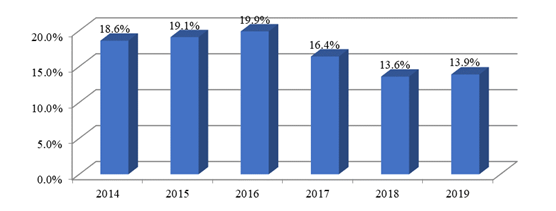
In 2019, the share of employees in the total number of people with disabilities was 13.9%. Since 2016, there has been an intensive decline in this indicator (by 6%). In the scientific literature, materials of scientific and practical conferences on employment, rehabilitation, vocational training of people with disabilities, the following factors hinder the provision of employment for disabled people: insufficient development of appropriate legislative mechanisms; poor development of urban infrastructure adapted for disabled people; socio-psychological aspects, etc. (Saralieva, 2018; Zaitseva & Halutornykh, 2018). However, not enough attention is paid to the practical aspects of organizing the employment of persons with disabilities.
Research Questions
The measures taken to promote the employment of people with disabilities will not be effective without comprehensive information support. On the one hand, when choosing vacancies, citizens of this category, and on the other hand, employers, when choosing potential employees, face difficulties that are caused by many specific aspects related to the physical characteristics of applicants, the state of the infrastructure.
The use of modern information technologies makes it possible to develop an information system aimed at supporting decision-making for both job seekers and employers, taking into account the following areas:
- individual characteristics of the applicant's health,
- the applicant's place of residence and his willingness to move,
- conditions of accessibility of the environment for people with disabilities,
- equipment of a special workplace for people with disabilities,
- desire of the applicant for professional retraining and the difficulty in choosing the direction of study for the professions in demand, etc.
Thus, the authors of the article propose the development of an IT service for the employment of people with disabilities.
Purpose of the Study
The main goal of developing a model of the "IT-Service for employment of people with disabilities" is to improve the quality of life of people with disabilities, raise the level of service in employment centers, retrain job seekers through the formation of effective groups convenient for infrastructure development for people with disabilities, facilitate employers' search for job seekers for quota-ready jobs who are willing to move and retrain.
Research Methods
IDEF0 (Integration Definition for Function Modeling) and UML (Unified Modeling Language) are the methodologies of structural and object-oriented approaches which were used during the research work.
According to the IDEF0 methodology, the design principle assumes the decomposition of the complex process of the information system functioning into simpler composite functions. The result is a hierarchical structural model of the system that is easy to analyze and interpret.
Using the IDEF0 methodology, a functional model of the system has been built, which reflects the logical sequence of service work processes, input and output data, mechanisms and controls.
The UML methodology allows describing, visualizing, designing and documenting software systems using different types of diagrams. For the web service for the formation of groups for advanced training for persons with disabilities, a diagram of use cases was built, which made it possible to highlight the actors and the main functions of the system. A use case diagram enables the customer, developer and end user to collaboratively discuss the functionality and behavior of the system (Kuhn, 1998; Miroshnichenko, 2008; Tsukanova, 2015).
The “IT-Service for employment of people with disabilities” IS model (Figure 02) was developed for employment centers interested in forming retraining groups, people with disabilities due to their lack of information on available vacancies, and employers in order to provide a complete picture of the available quotas for disabilities and their readiness to retrain and move, for this the task was set to develop the service, which would form groups for the retraining of people with disabilities and reflect their location on the map, in particular, people with disabilities should be immediately visible on the map; a person with disabilities who is ready to be retrained should be displayed, for example, in green colour, ready to move – in yellow. It is necessary in order to simplify the task of forming retraining groups for employment centers, and for employers to reduce the time it takes to find a candidate for a quota workplace who is ready to move and retrain.
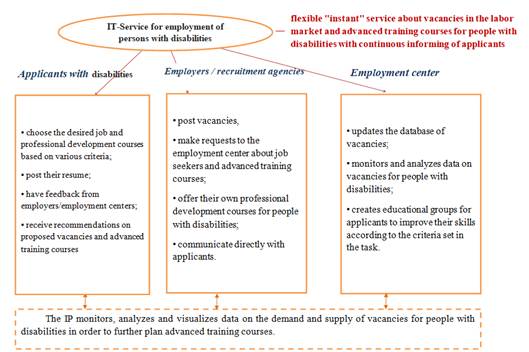
The principle of operation of the service is based on the interaction between the Employment Center - Candidate with HIA - Employer, and the service should work on the principle of instant notification of all participants in the process (sending SMS notifications and Instant Messaging Service (IMS), online consultants programs (OnlineSaler)".
For the correct operation of the service, it is necessary to regularly update the data of the bank of vacancies and quotas for HVZ at least once a day. For this, a data map of open sources of the service databases was built (Figure 03).
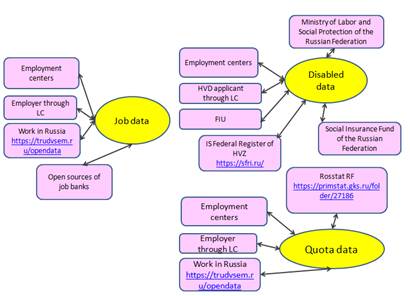
The diagram highlights the main open data, from which the service database will be replenished. The data from these sources are replenished and updated, i.e. they are constantly up to date.
To implement the constructed IS model, the following technological solution for IS functioning can be proposed: ASP.NET MVC Framework, Windows, Microsoft cloud technologies; Programming language: C #; Database: MySQL; Development environment: Microsoft Visual studio, ASP.NET web application (for implementing a web service), Azure Cloud (for publishing a site), Xamarin (for developing a mobile application); Third-party services: YandexDataLens; Launch Environment: Developer - Microsoft Cloud Azure Websites, Consumer – Browser of the used methods when performing a research.
Findings
As a result of the research work, a functional model and a diagram of options for using the service for the formation of groups for advanced training by persons with disabilities were built. Figure 04 shows the context diagram of the service according to the IDEF0 methodology.
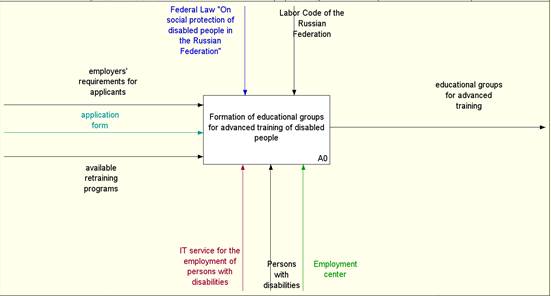
The input parameters of the system are the applicant's questionnaire, requirements for applicants and the available retraining programs. The governing elements are the Labor Code of the Russian Federation, the federal law “On social protection of disabled people in the Russian Federation”. Mechanisms of the system: persons with disabilities, the Center for Employment of the Population and the developed IT service for the employment of persons with disabilities. Output parameter (target result) - formed educational groups for advanced training.
Figure 05 shows the decomposition of the context diagram.
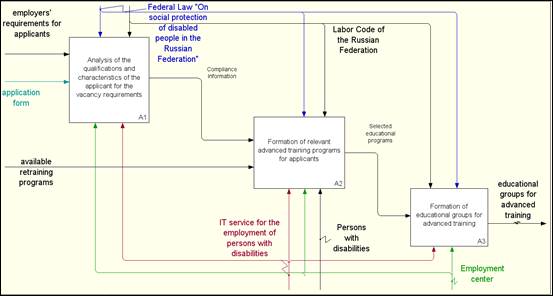
Thus, the service functionality consists of three main processes:
- analysis of the compliance of the qualifications and characteristics of the applicant with the requirements of the vacancy;
- formation of up-to-date professional development programs for applicants;
- formation of educational groups for advanced training.
The process of analyzing the qualifications and characteristics of applicants for vacancy requirements occurs in three stages (Figure 06).
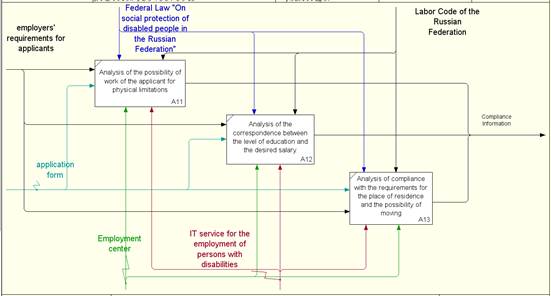
First of all, the service should compare the possibilities of the applicant to work on the vacancy, taking into account his physical limitations. Next, an analysis is made of the compliance of the applicant's educational level and the desired salary with the requirements of the vacancy. In addition, the system should analyze the proposed route from the applicant's place of residence to the place of work, and, if necessary, provide for the applicant's consent to move.
If the applicant fits the specified parameters, then the service generates a list of vacant positions for him. In this case, the list is made up of vacancies in different fields of activity. After that, the applicant studies the retraining programs available to him (Figure 07).
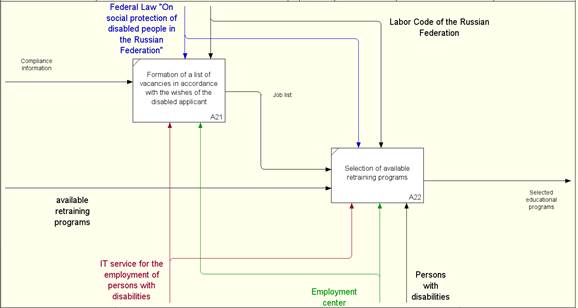
At the final stage, groups are formed taking into account the physical limitations of applicants, their ability to easily get to the place of study and the number of people in the group (Figure 08).
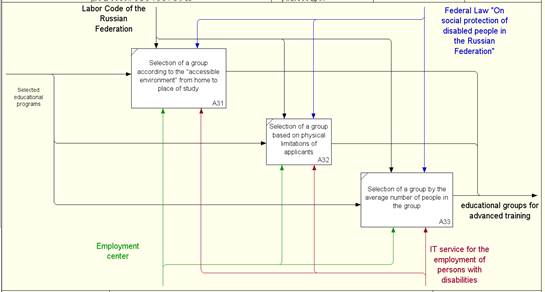
Thus, the functional model of the service showed that all the conditions of the problem were taken into account, and the necessary processes for the formation of educational groups for advanced training will be implemented in the system.
Figure 09 shows a diagram of the use cases for the service. Four actors have been identified: the employer, the applicant (person with disabilities), the Employment Center and the “Quota-Service” system being developed.
The employer registers and fills out a vacancy form in the service, namely, specifies the field of activity, position, salary, required work experience, education level, type of employment, work schedule.
The applicant registers and fills out a questionnaire indicating his personal data, place of residence, level of education, physical limitations, as well as the consent and the possibility of moving and retraining. In addition, it selects available retraining programs if it matches the job parameters.
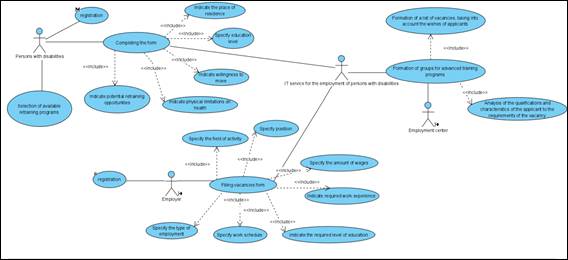
IT service for the employment of persons with disabilities, together with the Employment Center, forms educational groups for advanced training, carrying out all the processes described in the functional model of the system.
Conclusion
As a result of the work carried out, a model of the “IT-Service for employment of people with disabilities” was built, which provides an increase in the level of service in employment centers, retraining of job seekers through the formation of effective groups convenient in terms of infrastructure development for people with disabilities, facilitation of employers' search for job seekers for quota jobs ready to move and retraining. The model was developed according to the IDEF 0, UML methodology. In the future, based on this model, it is planned to develop a software product.
Acknowledgments
“IT-Service for employment of people with disabilities” was developed at the online Data-Hackathon within the international Competition "World AI and Data Challenge 2020", organized by the Agency for Strategic Initiatives (ASI) and The World Bank (July, 20-21, 2020).
References
Decree of the Government of the Russian Federation, No. 363 (March 29, 2019) (as revised on December 28, 2019).On the approval of the state program of the Russian Federation" Accessible Environment. Retrieved from: http://consultant.ru
Decree of the President of the Russian Federation, No. 203 (May 9, 2017). The Strategy for the development of the information society in the Russian Federation for 2017 – 2030. Retrieved from: http://consultant.ru
Federal State Statistics Service (2020). Report on Employment and Labor Market. Retrieved on 11.01 from: https://rosstat.gov.ru/labor_market_employment_salaries
Federal Law, No181-FL (November 24, 1995) (as amended on April 24, 2020). On Social Protection of Disabled People in the Russian Federation. Retrieved from: http://consultant.ru
Federal Law, No13-FL (March 05, 2012). On Ratification of the Convention on the Rights of Persons with Disabilities. Retrieved from: http://consultant.ru
Harris, P. (1998). Americans with disabilities still pervasively disadvantaged on a broad range of key indicators (Poll # 56). January 7, 2007.
Kuhn, T. (1998). Density matrix theory of coherent ultrafast dynamics Theory of Transport Properties of Semiconductor Nanostructures, 4. Electronic Materials (pp 173–214) London: Chapman and Hall.
Mironchuk, V. A., Sholin, Yu. A., & Sychanina, E. A. (2018). Employment of people with disabilities: mechanisms to stimulate the inclusion of people with disabilities in the labor process in the Russian Federation. Business. Education. Right, 4(45), 247-251.
Miroshnichenko, E. A. (2008). Programming technologies. 2nd edition. Tomsk, TPU Publishing House.
Nikolaenok, D. V., & Petrova, G. I. (2015). The problem of employment of persons with disabilities. Youth of Siberia - Science of Russia. Materials of the international scientific and practical conference (pp. 261-263). Krasnoyarsk: Siberian Institute of Business, Management and Psychology.
Pavlova, S. A. (2015). Analysis of foreign experience in the employment of disabled people. Medical and social problems of disability, 1, 77-82.
Saralieva, Z. Kh. (2018). Disabled people - disability – disability. N. Novgorod, NISOTS Publishing House.
Tsukanova, O. A. (2015). Methodology and tools for modeling business processes: textbook. St. Petersburg, ITMO Universitet.
Urazbayeva, N. R., Gareeva, S. R., & Taktaeva, Z. R. (2018). Employment of disabled people in the Russian Federation: benefits when hiring a disabled person for work. Bulletin of Contemporary Research, 12.11(27), 212-214.
Zaitseva, G. V., & Halutornykh, O. N. (2018). Employment of people with disabilities in the Russian Federation or What to do with equal human rights to work? Public administration. Electronic bulletin, 71,117-140.
Copyright information

This work is licensed under a Creative Commons Attribution-NonCommercial-NoDerivatives 4.0 International License.
About this article
Publication Date
01 July 2021
Article Doi
eBook ISBN
978-1-80296-112-6
Publisher
European Publisher
Volume
113
Print ISBN (optional)
-
Edition Number
1st Edition
Pages
1-944
Subjects
Land economy, land planning, rural development, resource management, real estates, agricultural policies
Cite this article as:
Khokhlova, O. A., Choizhalsanova, A. T., Bazarova, A. V., & Saibonova, L. N. (2021). The Model Of It Service For Employment Of People With Disabilities. In D. S. Nardin, O. V. Stepanova, & V. V. Kuznetsova (Eds.), Land Economy and Rural Studies Essentials, vol 113. European Proceedings of Social and Behavioural Sciences (pp. 767-777). European Publisher. https://doi.org/10.15405/epsbs.2021.07.92

